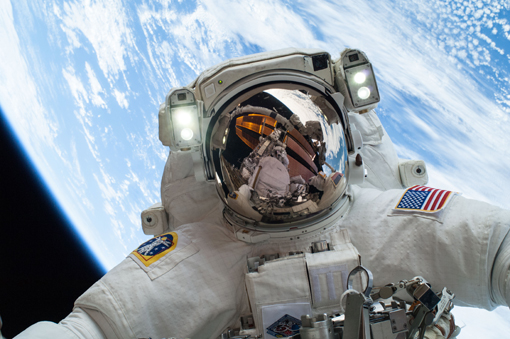Broadcasting Live … From Space
The third feature, presenting amazing images of the universe and, more specifically, planet Earth, has been a feature of televised space travel since the 1960s. Apollo showed us ever closer images of the Moon as each mission approached, landed, and retreated from it; as well as of our own planet in beautiful, increasingly detailed images, culminating in the Whole Earth image taken from Apollo 17, which helped to kick-start the global environmental movement. Live From Space boasted similar images taken by High-Definition cameras, and the frequency with which these were presented to the viewing audience throughout the programmes, and especially the live broadcast, made them one of the selling points of the whole project. A telling difference, however, is that there was no capability to give us another Whole Earth. Low Earth orbit restricts us to close-ups of the Earth’s surface, not the majesty of the planet suspended in the blackness of outer space. The profundity of vision is inevitably compromised; brought back down to Earth, one might say. And yet, there may be a significant payoff for this relatively myopic vision, which I will finish on a little later.
… here, the programme delivers big time; indeed, almost to the point of over-determination
The two shorter programmes were effectively representational markers of the first two traits, the two extremes of space travel in the current, Earth-orbit, age. The first programme detailed life as an astronaut in its everyday mundanity. The ISS ceaselessly orbits the Earth (sixteen times a day, we are told), and the astronauts methodically perform their work routines for months at a time: workaday repairs; exploratory scientific activity; adaptive ablutions; food packages from home, delivered via supply rocket. Little of this is particularly arresting, televisually. The second programme addressed the dreaded other extreme: the constant presence of imminent disaster. It focused on an incident when an astronaut nearly drowned during a spacewalk, when his drinking tube leaked water into his helmet. After a dramatic recovery, he survived; but the programme served its purpose – to present the ‘extreme danger’ quotient of space travel.
There is some sense of a clearing of decks here, of attempting to pre-address aspects of space travel that the producers didn’t want the live programme to be concerned with. It is as if the two shorter programmes are suggesting that what they cover could happen during the live show, but won’t; so viewers should tune in and watch what other exciting aspects of space travel the series has to present them with.
But this is not, in fact, what happens. The main programme partly, and simply, reiterates the issues, and indeed at times the content, of its preceding shows. The two on-board astronauts show us around the ISS, including the experiments ‘room’ and their sleeping quarters. We see what they eat and how they keep fit. So far, so comfortable. In an attempt to cover the danger aspect, pre-recorded segments explain how much of a continual threat collision with rogue space junk is to the ISS. The extreme danger of launch and re-entry are also stressed at several points during the show, both in pre-recorded segment and in conversation with the co-hosting astronauts.
 Learning on Screen
Learning on Screen